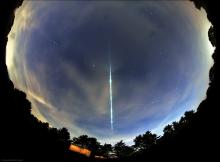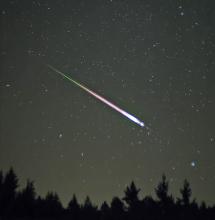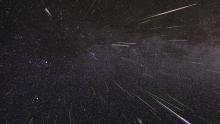Listen to today's episode of StarDate on the web the same day it airs in high-quality streaming audio without any extra ads or announcements. Choose a $8 one-month pass, or listen every day for a year for just $30.
You are here
Geminid Meteors
It’s hard to think of something that’s moving at 80,000 miles per hour as slow. But that’s the case for Geminid meteors. The bits of rock that create the meteors are a good bit slower than those that form most other showers. And that’s good for skywatchers — it means the meteors last a little longer than most others.
The Geminids are expected to be at their best tomorrow night, peaking before dawn on Wednesday. Unfortunately, the Moon will be in view then, washing out the fainter meteors. But many of the Geminids are fairly bright, so the shower is worth a look.
Geminids are spawned by what appears to be a dead comet. It’s lost its ices, leaving only a rocky core. So it doesn’t produce a tail when it gets close to the Sun, as active comets do. But it does shed grains of material along its orbit. Earth flies through this path every December.
Or at least it does now. The shower was first seen in 1862, with not many “shooting stars.” The rate has gone up since then. So today, the Geminids produce one of the best showers of the year — 75 to a hundred meteors per hour. But that’s under especially dark skies, with no moonlight to mess with the show.
By the way, the shower’s name comes from the constellation Gemini. That’s the point where the meteors appear to “rain” into the atmosphere. But they can streak across any portion of the sky, so you don’t have to look toward Gemini to see these bright slowpokes.
Script by Damond Benningfield






